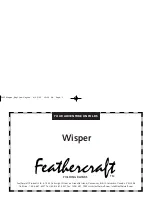
26
Chapter 4
PREVENT INJURY, DEATH, OR
PROPERTY DAMAGE FROM HIGH VOLTAGE!
DISCONNECT THE AC POWER SUPPLY
BEFORE ATTEMPTING TO BEGIN ANY
BATTERY CHARGER SERVICE WORK.
WARNING
!
TYPICAL BATTERY CHARGER
The battery charger features 40 amp output and universal
voltage for 3 battery circuits. This means that the battery
charger will operate from 95 volts through 277 volts either
at 50 or 60 Hz. This is helpful on docks that carry lower
voltage. The new electronic battery chargers are “smart”.
They will charge the batteries in 3 stages; bulk, absorption,
and
fl oat formats. The charger is designated to get the
maximum life out of your batteries, using micro computer
controlled charging.
It is recommended to keep the battery charger “on” at all
times when AC power is available for maximum battery life.
We recommend checking the battery water level weekly.
Fill batteries to
specifi ed levels using only distilled water.
The char-
ger is factory set to charge fl ooded lead acid batteries which
are the most common type available. The charger can be
reprogrammed to take gel cell or AGM batteries.
In the event the boat is switched over to different battery
designs, it is important that
all
batteries are of the same
type.
Remember, changing to a different battery type requires
re-programming the charger. Do not mix different de-
signed batteries because they need different charging
rates and voltages.
During bulk charge the battery charger brings up the bat-
tery charge state quickly, as the battery nears fully charged,
it switches over to absorption charge. Absorption charges
at a lower rate than bulk, until the battery is just a few %
away from full charge.
The battery charger display includes functional LED
information for charge current, charge voltage, charge
phase (bulk, absorption, fl oat), battery content measure-
ment and/or battery condition measurement as a % of
Ah capacity.
It is recommended that an ABYC certifi ed electrical tech-
nician perform any repairs or service. Do not attempt to
open the battery charger casing.
Refer to the vendor information for more detailed instruc-
tions.
Summary of Contents for 32 EXPRESS
Page 1: ...2011 Sport Yacht Collection S Y h C ll 32 EXPRESS OWNER S MANUAL...
Page 3: ...320102 12 6 2013 OWNER S MANUAL 32 EXPRESS...
Page 32: ...11 Safety On Board NAVIGATION LIGHT RULES...
Page 53: ...9 Rules Of The Road...
Page 54: ...10 Chapter 3...
Page 94: ...40 Chapter 4 TYPICAL 12 VOLT HELM SWITCH PANEL...
Page 106: ...52 Chapter 4 TYPICAL ELCI AC CIRCUIT FLOW CHART VOLTS VOLTS VOLTS VOLTS LINE...
Page 148: ...94 Chapter 4...
Page 149: ...95 Systems...
Page 150: ...96 Chapter 4...
Page 151: ...97 Systems...
Page 152: ...98 Chapter 4...
Page 153: ...99 Systems...
Page 154: ...100 Chapter 4...
Page 155: ...101 Systems...
Page 156: ...102 Chapter 4...
Page 157: ...103 Systems...
Page 158: ...104 Chapter 4...
Page 159: ...105 Systems...
Page 180: ...15 Engine Controls AFT FORWARD SIDEWAYS DIAGONALLY ROTATE JOYSTICK FUNCTIONS...
Page 262: ...22 Chapter 8 OVERBOARD DISCHARGE PAN DRAIN TYPICAL VECTOR COMPACT AC SYSTEM AIR FILTER...
Page 276: ...36 Chapter 8...
Page 300: ...9 Troubleshooting STEREO DIAGNOSTIC CHART...
Page 301: ...10 Chapter 9 STEREO DIAGNOSTIC CHART...
Page 302: ...11 Troubleshooting STEREO DIAGNOSTIC CHART...
Page 303: ...12 Chapter 9 TACHOMETER ELECTRONIC DIESEL...
Page 304: ...13 Troubleshooting TACHOMETER ELECTRONIC DIESEL...
Page 307: ...16 Chapter 9 THRUSTER BOW...
Page 309: ...18 Chapter 9 TYPICAL WINDLASS...
Page 329: ...6 Chapter 12 TECHNICAL DRAWINGS...
Page 330: ...Technical Information 12 7 32 EXPRESS GALVANIC ISOLATOR WIRING...
Page 331: ...Technical Information 12 8 TYPICAL NMEA 2000 NETWORK COMPONENTS...
Page 332: ...Technical Information 12 9 32 EXPRESS ELCI AC CIRCUIT FLOW CHART TYPICAL...
Page 333: ...Technical Information 12 10 32 EXPRESS MAIN AC SHIP S PANEL FRONT VIEW...
Page 334: ...Technical Information 12 11 32 EXPRESS MAIN AC SHIP S PANEL REAR VIEW...
Page 335: ...Technical Information 12 12 32 EXPRESS MAIN DC SHIP S PANEL FRONT VIEW...
Page 337: ...Technical Information 12 14 32 EXPRESS COCKPIT SWITCH PANEL...
Page 338: ...Technical Information 12 15 32 EXPRESS BATTERY VSR CIRCUITRY...
Page 339: ...Technical Information 12 16 32 EXPRESS BATTERY MANAGEMENT PANEL...
Page 340: ...Technical Information 12 17 32 EXPRESS HELM SWITCH PANEL...
Page 341: ...Technical Information 12 18 32 EXPRESS HELM BREAKER PANEL...
Page 342: ...Technical Information 12 19 32 EXPRESS VOLVO IGN MERC ANALOG EVC...
Page 343: ...Technical Information 12 20 32 EXPRESS FIREWALL TO MDP HARNESS ROUTING...
Page 344: ...Technical Information 12 21 32 EXPRESS DECK HARNESS ROUTING FORWARD...
Page 345: ...Technical Information 12 22 32 EXPRESS DECK HARNESS ROUTING AFT...
Page 346: ...Technical Information 12 23 32 EXPRESS HULL HARNESS ROUTING...
Page 347: ...Technical Information 12 24 32 EXPRESS GAUGE PANEL CONFIGURATIONS...
Page 348: ...Technical Information 12 25 32 EXPRESS TYPICAL DC GROUND CIRCUITRY...
Page 349: ...Technical Information 12 26 32 EXPRESS TYPICAL TRIM TAB SWITCH CIRCUITRY...
Page 350: ...Technical Information 12 27 32 EXPRESS TYPICAL BATTERY MANAGEMENT PANEL CIRCUITRY...
Page 351: ...Technical Information 12 28 32 EXPRESS TYPICAL GFCI CIRCUITRY...
Page 352: ...Technical Information 12 29 32 EXPRESS TYPICAL FIRE EXTINGUISHER GROUND CIRCUITRY...
Page 353: ...Technical Information 12 30 32 EXPRESS STEREO BLUETOOTH WIRING...
Page 357: ...Technical Information 12 34 32 EXPRESS MACHINERY LAYOUT...
Page 358: ...Technical Information 12 35 32 EXPRESS FUEL TANK EPA COMPLIANT...
Page 361: ...Technical Information 12 38 32 EXPRESS COCKPIT SEATING POSITION PLAN...
Page 362: ...Technical Information 12 39 32 EXPRESS RANGE OF VISIBILITY...
Page 363: ...Technical Information 12 40 32 EXPRESS DIMENSIONS APPROXIMATE...
Page 364: ...Technical Information 12 41 32 EXPRESS BOW PLAN WINDLASS...
















































